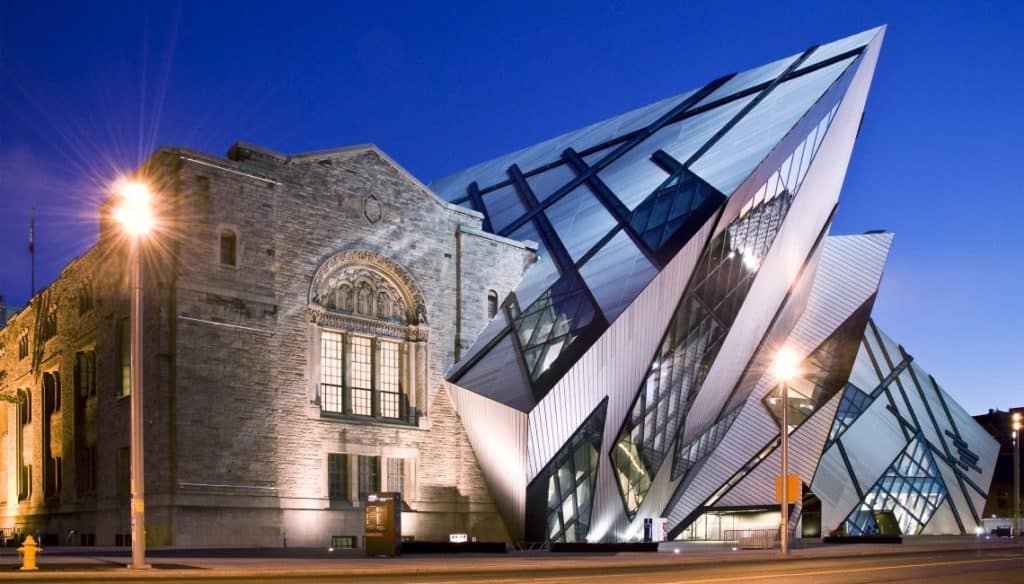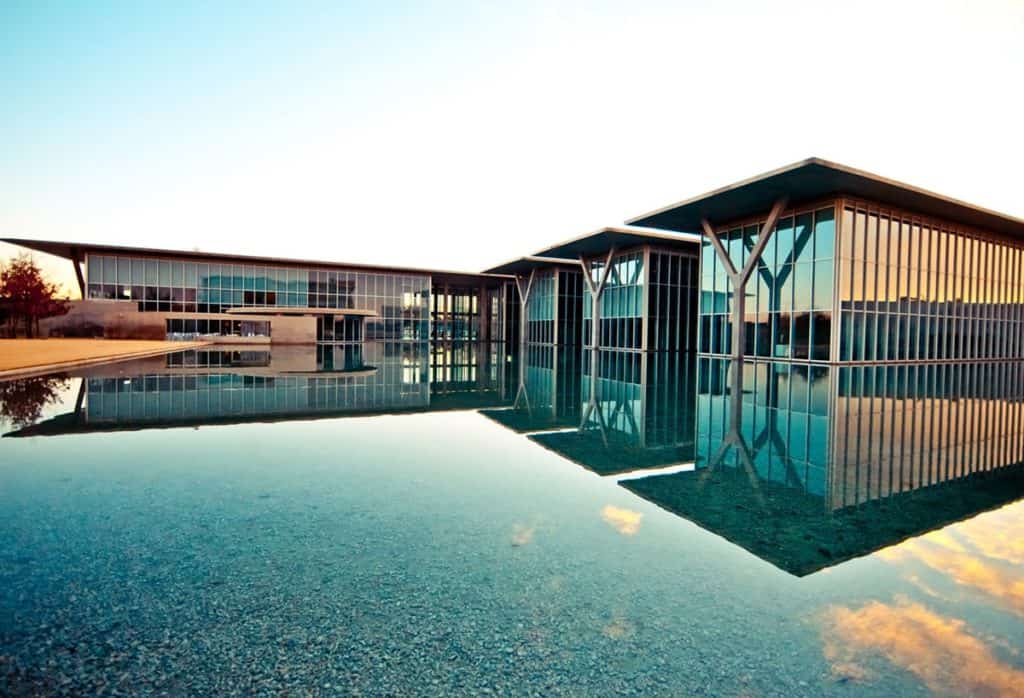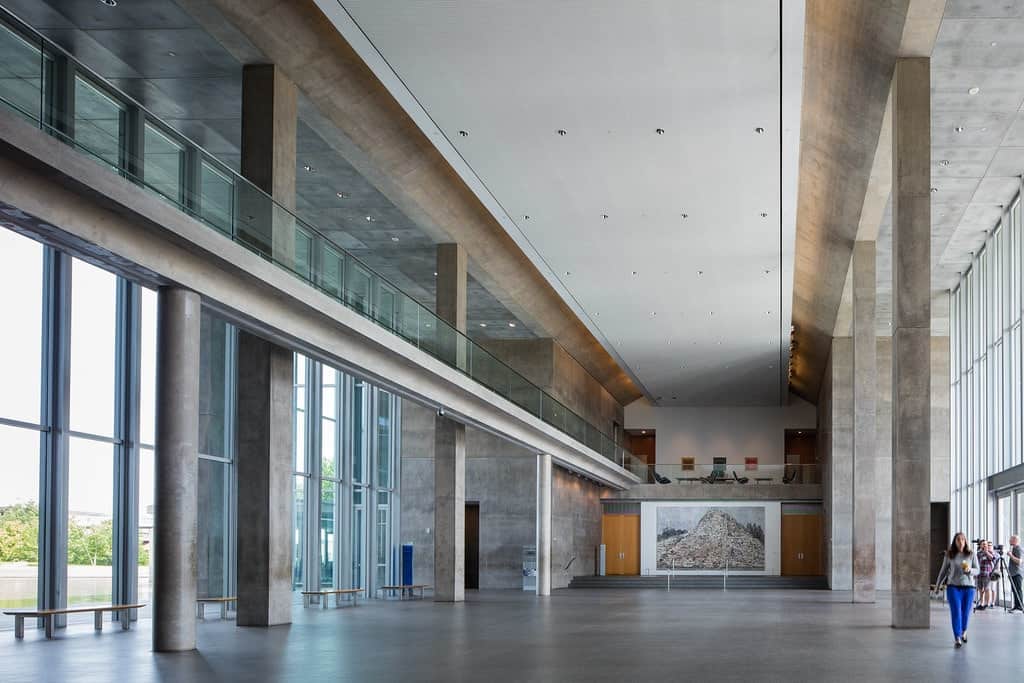Articles & Features
Museum Architecture Today: Contemporary Spaces, Bold Design

By: Tori Campbell
“Space will only have a life when people enter it. So the important role architecture can play, and that space plays within that architecture, is to encourage an interaction between people, between people and the ideas being presented in the paintings and sculpture, and most importantly between people themselves.”
Tadao Ando
Museum Architecture
Museum architecture often serves as a dramatic visual focal point for the city in which it is embedded, a nexus of cultural patronage and an ideal place for contemporary architects to show off innovative and daring designs. Architecture commissions for new museums have, in the last couple of decades, gone to star architects — visionaries at the top of their field, known for eye-catching buildings that stand out from the crowd. Take a look at some of the most arresting and spectacular museum architecture of the last century.
Guggenheim Museum: Bilbao, Spain

When New York City’s Guggenheim Museum created an outpost in Bilbao, Spain in the mid-1990s Canadian-American architect Frank Gehry was chosen to design the building. Gehry crafted his iconic swirling metallic sculptural building on the Estuary of Bilbao, creating at the same time, a brand new symbol for the Spanish city. In fact, the Guggenheim Bilbao would ultimately become the seminal example of how museums, or cultural institutions in general, can be utilised to regenerate post-industrial cities and bring new investment and life into the area. However, this style of regeneration often is critiqued for its predilection to gentrify the surrounding area, pricing out locals, and prioritising tourists’ needs over all others. Thus, this ‘Guggenheim affect’ of utilising ‘starchitecture’ to create new museum buildings, can be seen as both a positive and negative phenomenon. Despite this, Gehry’s museum architecture is undoubtedly striking in its own right, and the building is only enhanced by the sculptures flanking its waterside entrance.

Museum Of Islamic Art: Doha, Qatar

© Wahyu Pratomo and Kris Provoost
Located at the end of a seven kilometer-long waterfront promenade, Doha’s Museum of Islamic Art is built on an artificial island off the peninsula. Surrounded by numerous museum parks and the open harbor, the building and its surroundings were designed by Chinese-American architect I.M. Pei. When approached with the commission, Pei at 91 years old, had to be coaxed out of retirement for the project. However, Pei’s love for the architecture prevailed, and he took the project after traveling and studying for six months. During which time Pei learned about Muslim architecture, read ancient texts, and sought to understand the history of Islam in order to create the museum architecture that was eventually unveiled in 2008. The modern building has a respect for, and nod to, ancient Islamic architecture and design themes in its geometry, textures, and materials.

© Wahyu Pratomo and Kris Provoost
The Broad: Los Angeles, California, USA

The Broad, a contemporary art museum located in Downtown Los Angeles, lives adjacent to Walt Disney Concert Hall, another silvery spiraling Gehry building. Designed with this location in mind, the architecture firm Diller Scofidio + Renfro wanted to contrast with their neighbors, and thus made a bright metallic perforated exterior. Based on the concept of ‘the veil and the vault’ this perforated ‘honeycomblike’ exterior lies — like a veil — over the ‘vault’ of the building. This porous exterior allows filtered daylight into the indoor spaces, while the cool concrete body that forms the foundation and core of the building grounds the museum’s architecture. Opened in September 2015 with a party replete with celebrities, the building received mixed reviews; with some nicknaming it the ‘cheese grater’ due to its outward appearance.

Royal Ontario Museum: Toronto, Ontario, Canada

Originally built in 1914 in Italianate Neo-Romanesque style, the Royal Ontario Museum in Toronto, Ontario, Canada has undergone multiple additions since its first iteration. In 1973 the original building and its 1933 eastern wing addition, were listed as heritage buildings, complicating the task of architect Daniel Libeskind when he won the architecture bid to add an expansion. Libeskind’s ‘Michael Lee-Chin Crystal’ extension opened in 2007 to mixed reviews, having considerably exceeded time and budget constraints. No stranger to museum architecture, having already designed the Jewish Museum in Berlin, the London Metropolitan University Graduate Centre and the Fredric C. Hamilton Building at the Denver Art Museum; Libeskind’s extension was designed so as to not affect the heritage buildings, while adding a modern piece of interesting design. The Deconstructivist ‘Crystal’ of aluminum and glass stands atop a steel frame that holds the structure away from the existing walls and allows for an increased attendance of the museum — aiming to reach nearly 1.5 million visitors per year.

Modern Art Museum of Fort Worth: Forth Worth, Texas, USA

Designed by self-taught Japanese architect Tadao Ando, the Modern Art Museum of Fort Worth in Texas opened in 2002 and was an instant success in its serene poise and coherence. Focused on the emphasis of empty space to reflect the beauty of simplicity, Ando’s architectural style is deeply entrenched in Japanese culture and religion. Constructed only with concrete, glass, steel, aluminum, and granite; the museum’s architecture is minimal in every sense; providing the visitor with the feeling of Zen that Ando meditated upon in its design. The use of light and clean geometries allows for a weightlessness and immersion in nature, even while being ensconced indoors, as the five long, flat-roofed pavilions sit atop a 1.5-acre reflecting pond.

Museo Soumaya: Mexico City, Mexico

The 2011 Museo Soumaya, located in Plaza Carso, Mexico City, is a hulking 46-metre metallic monolith. Designed by Mexican architect Fernando Romero, and engineered with Ove Arup and Frank Gehry; the structure is clad in 16,000 hexagonal aluminum tiles, harkening back to Gehry’s propensity for the material. The six-story building is topped with a large circular skylight, allowing the daytime sun to illuminate the galleries, library, restaurant, and auditorium inside. Held by an exoskeleton of vertical curved steel columns designed by a company that manufactures offshore oil rigs, each of the six floors is uniquely shaped. The private museum, founded by businessman Carlos Slim, has received a critical reception with the belief that the development is of poor quality or will welcome too many tourists to the area.

The Hanoi Museum: Hanoi, Vietnam

Opened in 2010 for the Millennial Anniversary of Hanoi, The Hanoi Museum designed by gmp Architekten takes the form of an inverted pyramid. As an inverted pyramid, the top floor is the largest at 920.4 square metres, with the bottom floor coming in at a mere 420 square metres. This design, though aesthetically interesting, was also conceived in order to protect the artworks inside from the sun, while also shading the building, providing an energy efficient museum architecture. The square building is extremely accessible, as it can be entered through any of its four sides from the artificial park landscape surrounding it. Replete with water basins, sculptural elements, and areas for outdoor exhibits the parks around the museum aim to evoke the feeling of the traditional villages in the style of old Hanoi.

Niterói Contemporary Art Museum: Niterói, Brazil

Situated in the city of Niterói, Rio de Janeiro, Brazil, the Niterói Contemporary Art Museum is one of the city’s main landmarks. Perched upon Boa Viagem Beach, the land for the museum is the subject of a political scandal in which the land was purchased at an extremely low price and then was later sold for over 1,250,000 US dollars in 1996. Despite the scandal surrounding the museum, the building’s architecture is undoubtedly iconic. Designed by Brazilian architect Oscar Niemeyer, with the assistance of structural engineer Bruno Contarini, the intergalactic structure stands at 16 metres high with a cupola of 50 metres in diameter. The building has often been likened to a UFO, as the saucer-shaped modernist structure is set on a cliffside; appearing to have just landed on earth for the first time.

Louvre Abu Dhabi: Abu Dhabi, United Arab Emirates

Located in the Saadiyat Island Cultural District of Adu Dhabi, United Arab Emirates, the Louvre’s newest outpost opened in 2017. Designed by French architect Jean Nouvel the museum architecture appears to be a ‘seemingly floating dome structure’ surrounded by water. The patterned dome allows the daylight sun to stream through, aiming to represent the ‘rays of sunlight passing through date palm fronds in an oasis’. The cultural project holds massive significance in regards to the partnership between the French and Emirati governments, often a source of contention within France. The Louvre Abu Dhabi is the first notable cultural partnership that aims to make Saadiyat Island Cultural District the largest single cluster of world-class cultural institutions. In addition to the Louvre Abu Dhabi, the location plans to also host the Zayed National Museum, to be designed by Foster and Partners; the Guggenheim Abu Dhabi, expected to be the world’s largest Guggenheim; a performing arts centre designed by Zaha Hadid; and a maritime museum designed by Tadao Ando; among numerous additional arts pavilions.

© Laurian Ghinitoiu
Relevant sources to learn more
Want to learn more about architecture? Click here to explore the work of architects who also created beautiful visual art
Check out some stunning images of Jean Nouvel’s Louvre Abu Dhabi